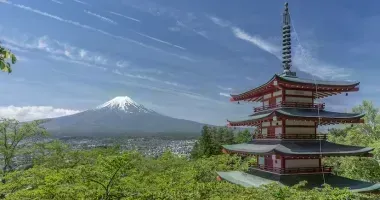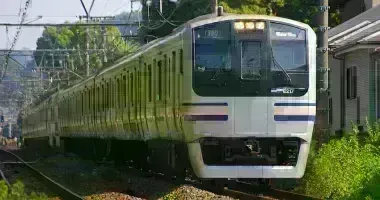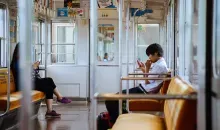Chiyoda Line Tokyo Subway
- Published on : 13/02/2023
- by : Joshua
- Youtube
The Chiyoda Line is a Tokyo subway line that connects seamlessly at both ends to the Odakyu Line to the west and the Joban Line to the east.
The Chiyoda Line is a Tokyo subway line serving south-west, central, and north-east Tokyo. The Chiyoda Line, with 20 stations, goes from Shibuya ward in a roughly straight line east to the Imperial Palace, then goes up to Ueno and Nishi-Nippori, then out a little further north-east.
The Chiyoda Line is an important link between the Joban Line in the north-east, which goes all the way up the east coast of Honshu, and the Odakyu Odawara Line in the south-west, which goes to the famous tourist areas of Hakone, in one direction, and Kamakura, in another.
The Chiyoda Line is operated by Tokyo Metro (as opposed to the other subway line operator, Toei). It is subway line no.9, its station numbers are prefixed with the letter C, and its color on subway maps is green. It is named after Chiyoda ward, which is the area centered on the Imperial Palace and where six of the line's stations are located.
History
Commuter congestion on the Ginza, Marunouchi and Hibiya subway lines during the booming 1960s prompted plans to build a new subway line: the Chiyoda Line. Tokyo Metro Co., Ltd. began work on the line in 1966 and the 20.9km between Ayase and Yoyogi-Koen stations was completed in 1972.
However, the single kilometer from Yoyogi-Koen station to Yoyogi-Uehara station took no less than 6 years to complete! Work on this final leg began in 1972, but a complicated relationship between the three companies involved: Tokyo Metro, Toei, and Odakyu, meant the project got bogged down and wasn't finished until 1978.
Chiyoda Line Stations
Yoyogi-Uehara | Yoyogi-Koen | Meiji-jingumae "Harajuku" | Omotesando | Nogizaka | Akasaka |
Kokkai-gijidomae | Kasumigaseki | Hibiya | Nijubashi-Mae "Marunouchi" | Otemachi |
Shin-Ochanomizu | Yushima | Nezu | Sendagi | Nishi-Nippori | Machiya | Kita-Senju | Ayase | Kita-Ayase
Notable Stations
Yoyogi-Uehara Station 代々木上原駅 C-01
Yoyogi-Uehara Station is in Tokyo's Shibuya ward. The station is above-ground, in fact, elevated, and doubles as a station for both the Chiyoda Line and the Odakyu Odawara Line. Of the station's four platforms, platforms 2 (arrivals only) and 3 are for the Chiyoda Line, and platforms 1, 2 and 4 for the Odakyu Line.
Only about one in every three Chiyoda Line trains that depart Yoyogi-Uehara Station end their journey at Ayase, which is the last station on the main stretch of the Chiyoda Line. The majority carry on to the Joban Line as far as Toride, Kashiwa or Matsudo stations. Likewise, only about one in three trains arriving at Yoyogi-Uehara end their journey there. Most carry on to the Odakyu Odawara Line (Hon-Atsugi, Isehara, Seijogakuen-mae, Mukogaoka-Yuen, Sagami-Ono stations) or the Odakyu Tama Line (Karakida).
The Tokyo Camii Mosque and Turkish Cultural Center is a short walk from Yoyogi-uehara Station. For Japanese music fans, the Koga Masao Museum of Music, dedicated to Masao Koga (1904-1978), the father of enka, is also nearby. Transfer at, or carry on through, Yoyogi-Uehara Station to the Odakyu Odawara Line.
Meiji-jingumae "Harajuku" Station 明治神宮前原宿駅 C-03
Meiji-jingumae "Harajuku" station is at the top end of the elegant sloping shopping street, Omotesando Boulevard, which is the road leading up to Meiji Jingu Shrine, the entrance to which is near Exit 2, near the JR Yamanote Line's Harajuku Station.
Besides the elegant shopping of Omotesando, there are streetier options nearby: Harajuku (Exit 3) with its full-on, fun-fair atmosphere down Takeshita-dori Avenue; and Cat Street (Exit 4) for a quieter, hipper scene (and more accommodation options).
Change here to Harajuku Station on the JR Yamanote Line (Exit 2) and Meiji-jingumae "Harajuku" station on the Tokyo Metro Fukutoshin Line.
Nishi-Nippori Station 西日暮里駅 C-16
Nishi-Nippori Station is in Tokyo's Arakawa ward: a mainly residential area. Nishi-Nippori Park is a small, one-third hectare (one acre) wooded park immediately south of the station with a toilet and smoking area. Just south of the park is the also heavily wooded and atmospheric Suwa Shrine ("O-Suwa-sama"), dating from the 13th century, with some unusual lion guardian statues, and a festival at the end of August. Just south of, and originally part of, the shrine is Jokoji Temple, with some notable statuary, and which is part of a cluster of other small Buddhist temples lining the stretch between Nishi-Nippori and Nippori stations.















